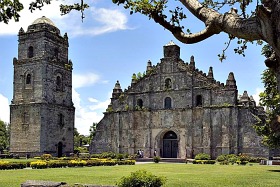Philippine Churches in Luzon - Outstanding Baroque Churches in the Philippines
Up here in northern Philippines, tourists wanting some escape from the congested metropolis more than 450 kilometers due south, can find great company in serene beaches in the country's far north west facing Luzon Bay.
You can start at the Hundred islands in Pangasinan, near the gulf where Gen. Douglas MacArthur and his allied forces landed on Jan 9, 1945 as part of the liberation of the archipelago from Japanese Imperial troops.
Then you can drive farther north and stay for some time at Nalinac Beach in the calm waters of Bauang town just south of the provincial capital of San Fernando City in La Union.
Not far from Nalinac is the Pug-os Beach in the coastal town of Cabugao, Ilocos Sur, which will host next summer one of the biggest conventions of Ilocano writers at home and abroad.
Near this garlic-producing town, where warriors walked at the turn of the 20th century and during the Japanese occupation, is Sadiay Baybay beach resort in Badoc, the town of Antonio and Juan Luna, the general of the Revolution and the country's foremost painter.
Due north are several beaches which have hosted regional and international conferences.
But beyond the beaches of the Ilocos Region, which stretch from Pagudpud town in this province near the boundary with Cagayan facing the Babuyan Channel to Rosales in Pangasinan near Tarlac, are yet other tourist come-ons.
 Paoay Church |
And residents have reason to be proud of these attractions.
Two of these Philippine churches are baroque churches, which have made it onto the UNESCO World Heritage List.
They are the Roman Catholic Church in Paoay town -- birthland of the Galaritas, the Blancos, the Villanuevas, the Toledos, the Valenzuelas, the Baysas -- and the Nuestra Senora de la Asuncion Church which is nestled on a hill in Santa Maria, rich in myth and folklore.
The Paoay Church, also called Simbaan ni San Agustin, was built in 1704 from coral stones, mortar and molasses. Historians call the church structure "earthquake baroque."
It is only a few kilometers from the inland Paoay Lake, which was mercilessly inundated during the onslaught of typhoon "Pepeng" in northern Philippines in 2009.
The lake, according to legend, took shape when the community north of the town proper exploded in much the same manner as the Biblical Sodom and Gomorrah.
Old hands in the town, inheritors of the silky smooth oral tradition, say Filipino builders of Philippine churches adopted a foreign architectural design and style which complemented local conditions.
Sitting on an earthquake-prone region, the builders apparently propped up the church's nave with thick stone buttresses.
They feature a scroll motif capped by intricately carved pinnacles.
While other concrete buildings and other church structures in the region have succumbed to earth shocks -- the Philippines straddles the Pacific belt of fire -- the Paoay Church has remained standing without a scratch.
Its outside feature is a crossbreed between a medieval Spanish church and a Javanese temple.
Nearly 90 kms south of this town is the other Heritage Lister in Santa Maria, the Church of Nuestra Señora de la Asuncion which stands on an elevated hill, legend suggests is the nipple of the mythical Aran, the energetic wife of Angalo (pronounced Ang-nga-lo).
The church door can be reached by walking up 85 stair flights from the cemented highway, a junction of the MacArthur Highway -- named after Gen. MacArthur -- which meanders through the region.
Historians say it was originally a citadel complex and was a center for Spanish missionaries who made inroads in the 16th century to evangelize the uplands after the arrival of Spanish conquerors in 1521. (Honor Blanco Cabie/PNA Philippine Churches )


